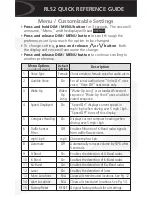
31
1. Install the radio into the mounting bracket.
2. Position the
radio into the
desired loca-
tion.
Mark the
edges of the
bracket on
the mounting
surface.
3. Remove the
mounting
bracket drill
template
from the
back of the
manual,
and use the
template to
mark the drill
holes on the
mounting surface.
4. Drill the holes for the mounting bracket; be sure to follow any special requirements of
the mounting surface.
5. Remove the bracket from the
radio, and use the mounting
hardware to secure the bracket
to the mounting surface.
6. Install the radio back into the
mounting bracket.
Connecting the radio
To operate correctly, your radio re-
quires two electrical connections:
• providing it with power from the
boat’s electrical system.
• connecting a VHF-FM marine an
-
tenna to the antenna connector.
1
2
Step 1:
Slide the radio
into the mounting
bracket.
Step 2:
Tighten the mounting knobs
to secure the radio in place.
Hex bolt
Washer
Spring washer
Hex nut
Mounting
bracket
Mounting
surface
Power supply Requirements
Nominal 13.8 VDC power supply with a nega
-
tive ground (10.5 VDC to 16.0 VDC).
Power leads should be kept as short as pos-
sible. A direct connection to the power supply
is ideal. Minimum of #14 AWG copper wire for
extensions up to 20 feet, 12 AWG wire for exten
-
sions from 20 to 35 feet, or 10 AWG wire for
extensions from 35 to 60 feet.
VHF Antenna Requirements
Male PL-259 connector
50 Ω impedance
Minimum 4 foot, 3 dB rated antenna for sail-
boats or 8 foot, 6dB rated antenna for power-
boats
Minimum RG-58 lead-in wire for antenna leads
up to 20 feet, RG-8X for antenna leads from 20
to 35 feet, or RG-8U for antenna leads from 35
to 60 feet.
Summary of Contents for MC-8050 DSC
Page 1: ...MC 8050 DSC owner s Manual...
















































